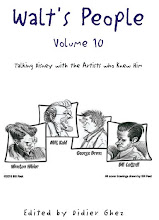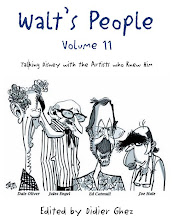As promised yesterday, here is another interview with JB, about Snow White and the Seven Dwarfs: The Art and Creation of Walt Disney's Classic Animated Film. Enjoy!
DG: Are there a lot of visual documents in the catalog which do not appear in the
“main book”?
JBK: Yes,
because that is the main function of the catalog: to serve as a guide to our
comprehensive Snow White exhibition
at the Walt Disney Family Museum. I’m proud of the illustrations in The Fairest One of All, and there are a
lot of them, but their purpose really is to illustrate the text. The catalog is
the other way around: it’s organized around the images, and then the images are
supplemented by the text.
DG: What will be the main surprises for Disney enthusiasts?
JBK: Mainly,
I think, just the tremendous variety and beauty of the artwork generated during
production of the film. We’ve all seen a fair sampling of Snow White production art, reproduced in various books and
articles, but the visual riches of this film aren’t exhausted yet—not by a long
stretch. This exhibition encompasses an amazing wealth of production art, from
concept art and model sheets through story sketches, layout drawings,
background paintings, and cleanup animation drawings as well as the finished
cel setups seen in the film. The art is drawn from the collections of both the
Walt Disney Family Foundation and the Walt Disney Animation Research Library,
and includes dozens of pieces that I don’t think have been seen before. For
anyone who is able to come to the Museum in person while the exhibition is
running, I highly recommend it! But the catalog is designed to reflect all
that, and it’s a feast for the eyes in its own right.
DG: Why release two books about Snow White
at the same time?
JBK: It
wasn’t originally planned that way. When we decided to do The Fairest One of All, it was just because it needed to be done,
and we weren’t thinking in terms of the timing. But then it turned out that the
publishing timetable coincided neatly with the 75th anniversary of the film,
and that led to the idea of a special Museum exhibition to mark the occasion,
and that led to the idea of a
separate book that would serve as a catalog for the exhibition. And the next
thing we knew, we had two Snow White
books in the works at the same time.
DG: What are the main chapters in that second book?
JBK: There
are twelve chapters altogether. The first chapter introduces the early stages
of Snow White story development in
the mid-1930s and illustrates the production process the studio used at that
time; the last chapter is about the success of the finished film and the
recognition it received around the world. The other ten chapters, in between,
follow the design logic of the exhibition, which in turn follows the continuity
of the film itself. In effect, you walk through Snow White’s story, from
beginning to end, by way of this extraordinary collection of art that brought
it to life on the screen.
DG: Are there some pieces of information in the second book, which do not appear in
the first one?
JBK: Yes,
actually there are. The basic historical account of the film doesn’t have the
depth or detail of that in The Fairest
One of All, but I’m proud to say the exhibition includes a number of
drawings and paintings that were used for highly specialized effects in making
the film. And for each of those pieces we were able to put in little
explanatory paragraphs to demonstrate how they were used in production. So the
end result, in this book, is that we have kind of a general overview of the
film’s history (I call it “Snow White lite”), punctuated with individual
closeups of these fascinating little details. I’m really happy that we were
able to give these two books separate identities, with exclusive features and
qualities of their own.























No comments:
Post a Comment